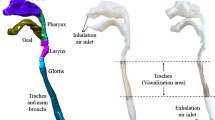Abstract
This paper adopts an Eulerian-Lagrangian approach to investigate the lock-up phenomenon (or trap phenomenon) of human exhaled droplets in a typical office room under displacement ventilation (DV). A particle-source-in-cell (PSI-C) scheme is used to correlate the concentration with the Lagrangian particle trajectories in computational cells. Respiratory droplets with sizes of 0.8 μm, 5 μm and 16 μm are released from a numerical thermal manikin (NTM). The influence factors including indoor temperature gradient, heat source configuration and exhalation modes are studied. It is found that large temperature gradient would result in trap phenomenon of small exhaled droplets (smaller than 5 μm). The intensive heat source near the NTM could help to transport the small droplets to the upper zone and decrease the concentration level in the trapped zone. Both nose-exhaled and mouth-exhaled small droplets would be trapped at the breathing height when temperature gradient is sufficiently high. However, the trap height of the droplets from mouth is a little bit higher. Because of large gravitational force, it is difficult for the thermal plume to carry 16 μm respiratory droplets to the upper zone.
Similar content being viewed by others
References
Bjorn E, Nielsen PV (2002). Dispersal of exhaled air and personal exposure in displacement ventilated rooms. Indoor Air, 12: 147–164.
Brohus H, Nielsen PV (1996). Personal exposure in displacement ventilated rooms. Indoor Air, 6: 157–167.
Chen C, Zhao B (2010). Some questions on dispersion of human exhaled droplets in ventilation room: answers from numerical investigations. Indoor Air, 20: 95–111.
Chao CYH, Wan MP (2006). A study of the dispersion of expiratory aerosols in unidirectional downward and ceiling-return type airflows using a multiphase approach. Indoor Air, 16: 296–312.
Chao CYH, Wan MP, Morawska L, Johnson GR, Ristovski ZD, Hargreanes M, Mengersen K, Corbett S, Li Y, Xie X, Katoshevski D (2009). Characterization of expiration air jets and droplet size distributions immediately at the mouth opening. Journal of Aerosol Science, 40: 122–133.
Chao CYH, Wan MP, To GNS (2008). Transport and removal of expiratory droplets in hospital ward environment. Aerosol Science and Technology, 42: 377–394.
Friberg B, Friberg S, Burman LG, Lundholm R, Ostensson R (1996). Inefficiency of upward displacement operating theatre ventilation. Journal of Hospital Infection, 33: 263–272.
Gao N, Niu J, Morawska L (2008). Distribution of respiratory droplets in enclosed environments under different air distribution methods. Building Simulation, 1: 326–335.
Gao NP, Niu JL, Perino M, Heiselberg P (2009). The airborne transmission of infection between flats in high-rise residential buildings: Particle simulation. Building and Environment, 44: 402–410.
Hamey PY (1982). The evaporation of airborne droplets. Msc Thesis, Bedford-shire, UK, Granfield Institute of Technology, 48–58.
Han K, Zhu XP, He F, Liu LG, Zhang LJ, Ma HL, Tang XY, Huang T, Zeng G, Zhu BP (2009). Lack of Airborne Transmission during Outbreak of Pandemic (H1N1) 2009 among Tour Group Members, China, June 2009. Emerging Infectious Diseases, 15: 1578–1581.
He Q, Niu J, Gao N, Zhu T, Wu J (2011). CFD study of exhaled droplet transmission between occupants under different ventilation strategies in a typical office room. Building and Environment, 46: 397–408.
Li Y, Nielsen PV, Sandberg M (2011). Displacement ventilation in hospital environments. ASHRAE Journal, 53: 86–88.
Mangili A, Gendreau MA (2005). Transmission of infectious diseases during commercial air travel. Lancet, 365: 989–996.
Morawska L, Johnson GR, Ristovski ZD, Hargreaves M, Mengersen K, Corbett S, Chao CYH, Li Y, Katoshevski D (2009). Size distribution and sites of origin of droplets expelled from the human respiratory tract during expiratory activities. Journal of Aerosol Science, 40: 256–269.
Mundt E (1995). Displacement ventilation systems—Convection flows and temperature gradients. Building and Environment, 30: 129–133.
Mui KW, Wong LT, Wu CL, Lai ACK (2009). Numerical modeling of exhaled droplets nuclei dispersion and mixing in indoor environments. Journal of Hazardous Materials, 167: 736–744.
Murakami S, Kato S, Nagano S, Tanaka S (1992). Diffusion characteristics of airborne particles with gravitational settling in a convection-dominant indoor flow field. ASHRAE Transaction, 98(1): 82–97.
Nicas M, Nazaroff WW, Hubbard A (2005). Toward understanding the risk of secondary airborne infection: Emission of respirable pathogens. Journal of Occupational and Environmental Hygiene, 2: 143–154.
Nielsen PV, Olmedo I, Adana MR, Grzelecki P, Jensen RL (2012). Airborne cross-infection risk between two people standing in surroundings with a vertical temperature gradient. HVAC & R Research, in press. DOI: 10.1080/10789669.2011.598441.
Qian H, Li Y, Nielsen P, Hyldgaard C, Wong T, Chwang A (2006). Dispersion of exhaled droplet nuclei in a two-bed hospital ward with three different ventilation systems. Indoor Air, 16: 111–128.
Seepana S, Lai ACK (2012). Experimental and numerical investigation of interpersonal exposure of sneezing in a full-scale chamber. Aerosol Science and Technology, 46: 485–493.
Skistad H, Mundt E, Nielsen PV, Hagstrom K, Railio J (2004). Displacement ventilation in non-industrial premises. Brussels: Rehva.
Wagner BG, Coburn BJ, Blower S (2009). Calculating the potential for within-flight transmission of influenza A (H1N1). BMC Medicine, 7: 81.
Wan MP, Chao CYH (2007). Transport characteristics of expiratory droplets and droplets nuclei in indoor environments with different ventilation airflow patterns. Journal of Biomechanical Engineering, 129: 341–353.
Zhang Z, Chen Q (2006). Experimental measurements and numerical simulations of particle transport and distribution in ventilated rooms. Atmospheric Environment, 40: 3396–3408.
Zhao B, Zhang Y, Li X, Yang X, Huang D (2004). Comparison of indoor aerosol particle concentration and deposition in different ventilated rooms by numerical method. Building and Environment, 39: 1–8.
Author information
Authors and Affiliations
Corresponding author
Rights and permissions
About this article
Cite this article
Gao, N., He, Q. & Niu, J. Numerical study of the lock-up phenomenon of human exhaled droplets under a displacement ventilated room. Build. Simul. 5, 51–60 (2012). https://doi.org/10.1007/s12273-012-0068-5
Received:
Revised:
Accepted:
Published:
Issue Date:
DOI: https://doi.org/10.1007/s12273-012-0068-5




